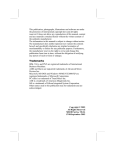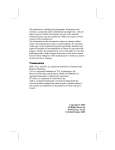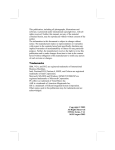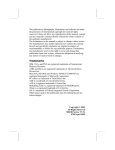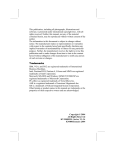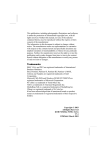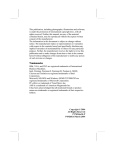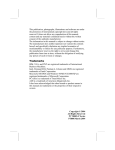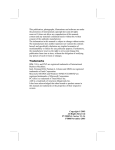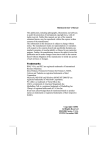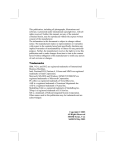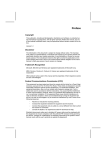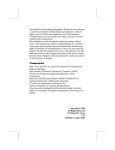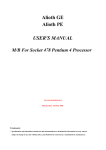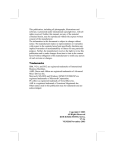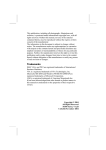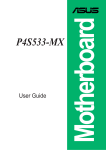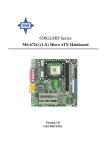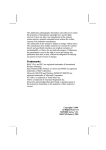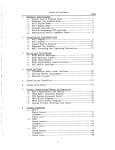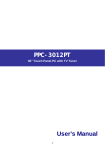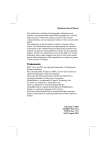Download User`s Manual
Transcript
This publication, photographs, illustrations and software are under the protection of international copyright laws and all rights reserved. It does not allow any reproduction of this manual, content and any materials contained herein without the written consent of the authentic manufacturer. The information in this manual is subject to change without notice. The manufacturer does neither represent nor warrant the contents hereof; and specifically disclaims any implied warranties of merchantability or fitness for any particular purpose. Furthermore, the manufacturer reserves the right to revise and change this publication from time to time, without the obligation of notifying any person of such revision or changes. Trademarks IBM, VGA, and PS/2 are registered trademarks of International Business Machines. AMD and Duron are registered trademarks of Advanced Micro Devices Inc. Microsoft, MS-DOS and Windows 98/ME/NT/2000/XP are registered trademarks of Microsoft Corporation. PC-cillin is a trademark of Trend Micro Inc. AMI is a trademark of Award Software Inc. A3D is a registered trademark of Aureal Inc. MediaRing Talk is a registered trademark of MediaRing Inc. 3Deep is a registered trademark of E-Color Inc. SiS is a trademark of Silicon Integrated System Corporation. Other names used in this publication may be trademarks and are acknowledged. Copyright © 2003 All Rights Reserved KOB 740 FDMx Series V7.5A S740/May 2003 Notice: Owing to Microsoft’s certifying schedule is various to every supplier, we might have some drivers not certified yet by Microsoft. Therefore, it might happen under Windows XP that a dialogue box (shown as below) pop out warning you this software has not passed Windows Logo testing to verify its compatibility with Windows XP. Please rest assured that our RD department has already tested and verified these drivers. Just click the “Continue Anyway” button and go ahead the installation. II Table of Contents Trademarks .............................................................................. I Chapter 1: Introduction....................................................................1 Key Features............................................................................2 Package Contents.....................................................................6 Static Electricity Precautions...................................................7 Pre-Installation Inspection.......................................................7 Chapter 2: Mainboard Installation...................................................8 Mainboard Components ..........................................................9 I/O Ports...................................................................................9 Installing the Processor..........................................................10 Installing Memory Modules ..................................................11 Jumper Settings .....................................................................12 Install the Mainboard.............................................................13 Connecting Optional Devices................................................14 Install Other Devices .............................................................16 Expansion Slots .....................................................................18 Chapter 3: BIOS Setup Utility.......................................................19 Introduction ...........................................................................19 Running the Setup Utility ......................................................20 Standard CMOS Setup Page..................................................21 Advanced Setup Page ............................................................22 Power Management Setup Page ............................................24 PCI / Plug and Play Setup Page.............................................25 Load Optimal Settings ...........................................................26 Load Best Performance Settings............................................26 Features Setup Page...............................................................27 CPU PnP Setup Page .............................................................29 Hardware Monitor Page.........................................................30 Change Password...................................................................30 Exit ........................................................................................31 Chapter 4: Software & Applications .............................................32 Introduction ...........................................................................32 Installing Support Software ...................................................33 Bundled Software Installation ...............................................35 III IV Chapter 1 Introduction This mainboard has a Socket-A support for the AMD K7 processors. The Socket-A processor’s front-side bus speed is 266MHz. This mainboard integrates the SiS740 Northbridge and SiS962L Southbridge chipsets that support DDR 266MHz, Ultra DMA 33/66/100/133 function and remarkably high system performance under all types of system operations. The mainboard supports the built-in AC97 Codec, two 32-bit PCI slots, one CNR (Communications and Networking Riser) slot, and a built-in 10BaseT/100BaseTX Network Interface (optional). This mainboard has the embedded 256-bit 3D AGP Graphics Accelerator with 64MB frame buffer, supporting AGP 4X 266MHz mode up to 1GB/s bandwidth, which provides a direct connection between the graphics sub-system and memory so that the graphics do not have to compete for processor time with other devices on the PCI bus. The mainboard supports built-in USB 2.0 providing higher bandwidth, implements Universal Serial Bus Specification Revision 2.0 and is compliant with UHCI 1.1 and EHCI 0.95. There is a full set of I/O ports including two PS/2 ports for mouse and keyboard, one serial port, one parallel port, one VGA port and maximum six USB2.0 ports– four back-panel ports and onboard USB header USB2 providing two extra ports by connecting the Extended USB Module to the mainboard. The board is Micro ATX size and has power connectors for an ATX power supply. Key Features The key features of this mainboard include: Socket-A Processor Support ♦ Supports AMD Athlon XP/Athlon/Duron processors ♦ Supports 266 MHz Front-Side Bus Chipset There are SiS740 Northbridge and SiS962L Southbridge in this chipset in accordance with an innovative and scalable architecture with proven reliability and performance. A few of the chipset’s advanced features are: ♦ Integrate a high performance and high quality 3D/2D Graphical Accelerator, Video Accelerator and Motion Compensation MPEG1/MPRII Video Decoder ♦ Integrate a high performance 2.1GB/s DDR266 Memory controller to sustain the bandwidth demand from the integrated GUI, host processor, as well as the multi I/O masters ♦ Integrate one Universal Serial Bus 2.0 Host Controllers, the Audio Controller with AC97 Interface, the Ethernet MAC Controller w/ standard MII interface, three Universal Serial Bus 1.1 Host Controllers, the IDE Master/Slave controllers, and SiS MuTIOL technology Memory Support ♦ Two 184-pin DIMM sockets for DDR memory modules ♦ Support DDR 266MHz memory bus ♦ Maximum installed memory is 1GB VGA ♦ Embeded 256-bit 3D AGP Graphics Accelerator with 64MB frame buffer ♦ Supports AGP 4X 266 MHz mode up to 1GB/s bandwidth ♦ Supports 333MHz true-colorm RAMDAC, resolution up to 2048 x 1536 x 16 bpp NI ♦ Supports AGP Rev. 2.0 Spec. Compliant 2 Expansion Slots ♦ One CNR (Communications and Networking Riser) slot ♦ Two 32-bit PCI slots for PCI 2.2-compliant bus interface Onboard IDE channels ♦ Primary and Secondary PCI IDE channels ♦ Support for PIO (programmable input/output) modes ♦ Support for Multiword DMA modes ♦ Support for Bus Mastering and Ultra DMA ATA 33/66/100/133 modes Power Supply and Power Management ♦ ATX power supply connector ♦ Meets ACPI 1.0b and APM 1.2 requirements, keyboard power on/off AC97 Audio Codec ♦ Compliant with AC’97 2.2 specification ♦ Full-duplex Codec with independent and variable sampling rate ♦ Earphone Buffer Built-In, SNR up to 90db ♦ 4Ch DAC, support 4-channel speak-out ♦ Advanced power management support Onboard I/O Ports The mainboard has a full set of I/O ports and connectors: ♦ Two PS/2 ports for mouse and keyboard ♦ One serial port ♦ One VGA port ♦ One parallel port ♦ Six USB2.0 ports (four back-panel ports, onboard USB header providing two extra ports) ♦ Audio jacks for microphone, line-in and line-out Built-in Ethernet LAN (optional) ♦ 10Base-T/100Base-TX Physical Layer Solution ♦ Dual Speed – 100/10 Mbps 3 ♦ MII Interface to Ethernet Controller/Configuration & Status ♦ Auto Negotiation: 10/100, Full/Half Duplex ♦ Meet All Applicable IEEE802.3, 10Base-T and 100BaseTX Standards USB 2.0 ♦ Compliant with Universal Serial Bus Specification Revision 2.0 ♦ Compliant with Intel’s Enhanced Host Controller Interface Specification Revision 0.95 ♦ Compliant with Universal Host Controller Interface Specification Revision 1.1 ♦ PCI multi-function device consists of two UHCI Host Controller cores for full-/low-speed signaling and one EHCI Host Controller core for high-speed signaling ♦ Root hub consists 4 downstream facing ports with integrated physical layer transceivers shared by UHCI and EHCI Host Controller ♦ Support PCI-Bus Power Management Interface Specification release 1.1 ♦ Legacy support for all downstream facing ports BIOS Firmware This mainboard uses AMI BIOS that enables users to configure many system features including the following: ♦ Hard drives, diskette drives, and peripherals ♦ Power management ♦ CPU parameters and memory timing ♦ Hardware monitoring parameters The firmware can also be used to set parameters for different processor clock speeds. Bundled Software ♦ PC-Cillin2002 provides automatic virus protection under Windows 98/ME/NT/2000/XP ♦ MediaRing Talk provides PC to PC or PC to Phone internet phone communication 4 ♦ 3Deep delivers the precise imagery and displays accurate color in your monitor ♦ PC DJ is a dual-MP3 player that enables users to actually mix music right on their own personal computers. ♦ Adobe Acrobat Reader V5.0 is the software to help users read .PDF files. Dimensions ♦ Micro ATX form factor (24.4cm x 19cm) Note: Hardware specifications and software items are subject to change without notification. 5 Package Contents Your mainboard package ships with the following items: The mainboard The User’s Manual One diskette drive ribbon cable and bracket (optional) One IDE drive ribbon cable and bracket Software support CD Optional Accessories You can purchase the following optional accessories for this mainboard. Extended USB module CNR v.90 56K Fax/Modem card Card Reader (You can buy your own Card Reader from the third party, but please contact your local Card Reader vendor on any issues of the specification and compatibility.) 6 Static Electricity Precautions Static electricity could damage components on this mainboard. Take the following precautions while unpacking this mainboard and installing it in a system. 1. Don’t take this mainboard and components out of their original static-proof package until you are ready to install them. 2. While installing, please wear a grounded wrist strap if possible. If you don’t have a wrist strap, discharge static electricity by touching the bare metal of the system chassis. 3. Carefully hold this mainboard by its edges. Do not touch those components unless it is absolutely necessary. Put this mainboard on the top of static-protection package with component side facing up while installing. Pre-Installation Inspection 1. Inspect this mainboard whether there are any damages to components and connectors on the board. 2. If you suspect this mainboard has been damaged, do not connect power to the system. Contact your mainboard vendor about those damages. 7 Chapter 2 Mainboard Installation To install this mainboard in a system, please follow the instructions in this chapter: Identify the mainboard components Install a CPU Install one or more system memory modules Verify that all jumpers or switches are set correctly Install the mainboard in a system chassis (case) Connect any extension brackets or cables to connecting headers on the mainboard Install other devices and make the appropriate connections to the mainboard connecting headers. Note: 1. Before installing this mainboard, make sure jumper JP1 is under Normal setting. See this chapter for information about locating JP1 and the setting options. 2. Never connect power to the system during installation; otherwise, it may damage the mainboard. Mainboard Components Use the diagram below to identify the major components on the mainboard. Note: Any jumpers on your mainboard that do not appear in the illustration above are for testing only. I/O Ports The illustration below shows a side view of the built-in I/O ports on the mainboard. (shared with JP2) (optional) 9 PS/2 Mouse PS/2 Keyboard Parallel port (PRN) COM1 VGA LAN Port (optional) USB Ports Use the upper PS/2 port to connect a PS/2 pointing device. Use the lower PS/2 port to connect a PS/2 keyboard. Use the PRN to connect printers or other parallel communications devices. Use the COM port to connect serial devices such as mice or fax/modems. COM1 is identified by the system as COM1. Use the VGA port to connect VGA devices. Connect an RJ-45 jack to the LAN port to connect your computer to the Network. Use the USB ports to connect USB devices. Note: The lower USB port located beside the VGA port is shared with the JP2 connector Audio Ports Use the three audio ports to connect audio devices. The first jack is for stereo Line-In signal. The second jack is for stereo LineOut signal. The third jack is for Microphone. Installing the Processor This mainboard has a Socket 462 processor socket. When choosing a processor, consider the performance requirements of the system. Performance is based on the processor design, the clock speed and system bus frequency of the processor, and the quantity of internal cache memory and external cache memory. CPU Installation Procedure Follow these instructions to install the CPU: 1. Unhook the CPU socket’s locking lever by pulling it away from socket and raising it to the upright position. 2. Match the pin 1 corner of CPU socket to the one of processor, and insert the processor into the socket. Do not use force. 3. Push the locking lever down and hook it under the latch on the edge of socket. 4. Apply thermal grease to the top of the CPU. 10 5. Lower the CPU fan/heatsink unit onto the CPU and CPU socket, and then use the retention module clamps to snap the fan/heatsink into place. 6. Plug the CPU fan power cable into the CPU cooling fan power supply (CPUFAN1) on the mainboard. Installing Memory Modules This mainboard accommodates two 184-pin 2.5V unbuffered Double Data Rate SDRAM (DDR SDRAM) Dual Inline Memory Module (DIMM) sockets, and supports up to 1.0 GB of 266 MHz DDR SDRAM. DDR SDRAM is a type of SDRAM that supports data transfers on both edges of each clock cycle (the rising and falling edges), effectively doubling the memory chip’s data throughput. DDR DIMMs can synchronously work with 100 MHz or 133 MHz memory bus. DDR SDRAM provides 1.6 GB/s or 2.1 GB/s data transfer rate depending on whether the bus is 100 MHz or 133 MHz. DDR SDRAM uses additional power and ground lines and requires 184-pin 2.5V unbuffered DIMM module. DDR1 DDR2 11 Installation Procedure These modules can be installed with up to 1 GB system memory. Refer to the following to install the memory modules. 1. Push the latches on each side of the DIMM socket down. 2. Align the memory module with the socket. The DIMM sockets are keyed with notches and the DIMMs are keyed with cutouts so that they can only be installed correctly. 3. Check that the cutouts on the DIMM module edge connector match the notches in the DIMM socket. 4. Install the DIMM module into the socket and press it firmly down until it is seated correctly. The socket latches are levered upwards and latch on to the edges of the DIMM. 5. Install any remaining DIMM modules. Jumper Settings Jumpers are sets of pins connected together with jumper caps. The jumper caps change the mainboard’s operation by changing the electronic circuits on the mainboard. If we connect two pins with a jumper cap, these pins are SHORT; if remove a jumper cap from these pins, they are OPEN. JP1 1 12 Jumper JP1: Clear CMOS Memory This jumper can clear the CMOS memory. You may need to clear the CMOS memory if the settings in the Setup Utility are incorrect that your mainboard can’t operate. To clear the CMOS memory, disconnect all the power cables, and then move the jumper cap into the CLEAR setting for a few seconds. Function Clear CMOS Memory Normal Operation Jumper Setting Short Pins 1-2 Short Pins 2-3 Install the Mainboard Install the mainboard in a system chassis (case). The board is a Micro ATX size mainboard. You can install this mainboard in an ATX case. Ensure your case has an I/O cover plate that matches the ports on this mainboard. Install the mainboard in a case. Follow the instructions provided by the case manufacturer using the hardware and internal mounting points on the chassis. 1 SYSFAN1 ATX_PWR 1 SW1 13 Connect the power connector from the power supply to the ATX_PWR connector on the mainboard. If there is a cooling fan installed in the system chassis, connect the cable from the cooling fan to the SYSFAN1 fan power connector on the mainboard. Connect the case switches and indicator LEDs to the SW1 header. Pin 1 3 5 7 9 Signal HD_LED_P HD_LED_N RESET_SW_N RESET_SW_P RSVD_DNU Pin 2 4 6 8 10 Signal FP PWR/SLP FP PWR/SLP POWER_SW_P POWER_SW_N KEY Connecting Optional Devices Refer to the following for information on connecting the mainboard’s optional devices: JP2 1 1 AUDIO1 1 USB2 1 IR1 1 SPK1 SPK1: Speaker Connector Connect the cable from the PC speaker to the SPK1 header on the mainboard. Pin 1 3 Signal +5V GND Pin 2 4 14 Signal NC SPKR AUDIO1: Front Panel Audio Header This header allows the user to install auxiliary front-oriented microphone and line-out ports for easier access. Pin 1 3 5 7 9 Signal AUD_MIC AUD_MIC_BIAS AUD_FPOUT_R HP_ON AUD_FPOUT_L Pin 2 4 6 8 10 Signal AUD_GND AUD_VCC AUD_RET_R KEY AUD_RET_L USB2: Front panel USB Connector The mainboard has USB ports installed on the rear edge I/O port array. Additionally, some computer cases have USB ports at the front of the case. If you have this kind of case, use auxiliary USB connector USB2 to connect the front-mounted ports to the mainboard. Pin 1 3 5 7 9 Signal VERG_FP_USBPWR0 USB_FP_P0USB_FP_P0+ GROUND KEY Pin 2 4 6 8 10 Signal VERG_FP_USBPWR0 USB_FP_P1USB_FP_P1+ GROUND NC 1. Locate the USB2 header on the mainboard. 2. Plug the bracket cable onto the USB2 header. 3. Remove a slot cover from one of the expansion slots on the system chassis. Install an extension bracket in the opening. Secure the extension bracket to the chassis with a screw. JP2: USB Card Reader Connector (optional) This connector is for connecting internal USB card reader. You can use a card reader to read or transfer files and digital images to your computer. Pin 1 3 5 Signal VCC USB+ KEY Pin 2 4 Signal USBGND The JP2 is shared with one of the USB ports of the I/O back panel. The USB port is located beside the serial port connectors. See “I/O Ports” for more information. 15 Please check the pin assignment of the cable and the USB header on the mainboard. Make sure the pin assignment will match before plugging in. Any incorrect usage may cause unexpected damage to the system. The vendor won’t be responsible for any incidental or consequential damage arising from the usage or misusage of the purchased product. IR1: Infrared Port The infrared port allows the wireless exchange of information between your computer and similarly equipped devices such as printers, laptops, Personal Digital Assistants (PDAs), and other computers. Pin 1 3 5 Signal NC +5V IRTX Pin 2 4 6 Signal KEY GND IRRX 1. Locate the infrared port IR1 header on the mainboard. 2. If you are adding an infrared port, connect the ribbon cable from the port to the IR1 header and then secure the port to an appropriate place in your system chassis. Install Other Devices Install and connect any other devices in the system following the steps below. 1 1 1 FDC1 IDE1 IDE2 16 Floppy Disk Drive The mainboard ships with a floppy disk drive cable that can support one or two drives. Drives can be 3.5” or 5.25” wide, with capacities of 360K, 720K, 1.2MB, 1.44MB, or 2.88MB. Install your drives and connect power from the system power supply. Use the cable provided to connect the drives to the floppy disk drive connector FDC1. IDE Devices IDE devices include hard disk drives, high-density diskette drives, and CD-ROM or DVD-ROM drives, among others. The mainboard ships with an IDE cable supporting one or two IDE devices. If you connect two devices to a single cable, you must configure one of the drives as Master and one of the drives as Slave. The IDE device’s documentation tells you how to configure a Master or a Slave device. The Master device connects to the end of the cable. Install the device(s) and connect power from the system power supply. Use the cable provided to connect the device(s) to the Primary IDE channel connector IDE1 on the mainboard. If you want to install more IDE devices, you can purchase a second IDE cable and connect one or two devices to the Secondary IDE channel connector IDE2 on the mainboard. If you have two devices on the cable, one must be Master and one must be Slave. Internal Sound Connections If you have installed a CD-ROM drive or DVD-ROM drive, you can connect the drive audio cable to the onboard sound system. 1 CD1 17 When you first start up your system, the BIOS should automatically detect your CD-ROM/DVD drive. If it doesn’t, enter the Setup Utility and configure the CD-ROM/DVD drive that you have installed. On the mainboard, locate the 4-pin connectors CD1. Pin 1 2 3 4 Signal CD IN L GND GND CD IN R Expansion Slots This mainboard has one CNR and two 32-bit PCI slots. CNR PCI2 PCI1 Follow the steps below to install a CNR/PCI expansion card. 1. Locate the CNR or PCI slots on the mainboard. 2. Remove the blanking plate of the slot from the system chassis. 3. Install the edge connector of the expansion card into the slot. Ensure the edge connector is correctly seated in the slot. 4. Secure the metal bracket of the card to the system chassis with a screw. 18 Chapter 3 BIOS Setup Utility Introduction The BIOS Setup Utility records settings and information of your computer, such as date and time, the type of hardware installed, and various configuration settings. Your computer applies the information to initialize all the components when booting up and basic functions of coordination between system components. If the Setup Utility configuration is incorrect, it may cause the system to malfunction. It can even stop your computer booting properly. If it happens, you can use the clear CMOS jumper to clear the CMOS memory which has stored the configuration information; or you can hold down the Page Up key while rebooting your computer. Holding down the Page Up key also clears the setup information. You can run the setup utility and manually change the configuration. You might need to do this to configure some hardware installed in or connected to the mainboard, such as the CPU, system memory, disk drives, etc. Running the Setup Utility Every time you start your computer, a message appears on the screen before the operating system loading that prompts you to “Hit <DEL>if you want to run SETUP”. Whenever you see this message, press the Delete key, and the Main menu page of the Setup Utility appears on your monitor. AMIBIOS SIMPLE SETUP UTILITY – VERSION 1.21.12 (C) 2000 American Megatrends, Inc. All Rights Reserved Standard CMOS Setup Features Setup Advanced Setup CPU PnP Setup Power Management Setup Hardware Monitor PCI / Plug and Play Setup Change Password Load Optimal Settings Exit Load Best Performance Settings Esc : Quit ↑ ↓ ← →: Select Item (Shift)F2 : Change Color F5 : Old Values F6 : Optimal values F7 : Best performance values F10 : Save&Exit Standards CMOS setup for changing time, date, hard disk type, etc. You can use the cursor arrow keys to highlight any of the options on the main menu page. Press Enter to select the highlighted option. To leave the setup utility, press the Escape key. To cycle through the Setup Utility’s optional color schemes hold down the Shift key and press F2. Some of the options on the main menu page lead to tables of items with installed values. In these pages, use the cursor arrow keys to highlight the items, and then use the PgUp and PgDn keys to cycle through the alternate values for each of the items. Other options on the main menu page lead to dialog boxes requiring you to answer Yes or No by hitting the Y or N keys. If you have already made changes to the setup utility, press F10 to save those changes and exit the utility. Press F5 to reset the changes to the original values. Press F6 to install the setup utility with a set of default values. Press F7 to install the setup utility with a set of high-performance values. 20 Standard CMOS Setup Page Use this page to set basic information such as the date, the time, the IDE devices, and the diskette drives. If you press the F3 key, the system will automatically detect and configure the hard disks on the IDE channels. AMIBIOS SETUP – STANDARD CMOS SETUP (C) 2000 American Megatrends, Inc. All Rights Reserved Date (mm/dd/yy) : Thu Apr 10, 2003 Time (hh/mm/ss) : 18:06:57 Type Pri Master : Auto Pri Slave : Auto Sec Master : Auto Sec Slave : Auto LBA Blk PIO 32Bit Size Cyln Head WPcom Sec Mode Mode Mode Mode On On On On Floppy Drive A : 1.44 MB 31/2 Floppy Drive B : Not Installed Month : Jan – Dec Day : 01 – 31 Year : 1901 – 2099 Date & Time Pri Master Pri Slave Sec Master Sec Slave Floppy Drive A Floppy Drive B ESC : Exit ↑↓ : Select Item PU/PD/+/- : Modify (Shift)F2 : Color F3 : Detect All HDD Use these items to set the system date and time Use these items to configure devices connected to the Primary and Secondary IDE channels. To configure an IDE hard disk drive, choose Auto. If the Auto setting fails to find a hard disk drive, set it to User, and then fill in the hard disk characteristics (Size, Cyls, etc.) manually. If you have a CD-ROM drive, select the setting CDROM. If you have an ATAPI device with removable media (e.g. a ZIP drive or an LS-120) select Floptical. Use these items to set the size and capacity of the floppy diskette drive(s) installed in the system. 21 Advanced Setup Page Use this page to set more advanced information about your system. Take some care with this page. Making changes can affect the operation of your computer. AMIBIOS SETUP – ADVANCED SETUP (C) 2000 American Megatrends, Inc. All Rights Reserved Shared Memory Size Quick Boot 1st Boot Device 2nd Boot Device 3rd Boot Device Try Other Boot Devices S.M.A.R.T. for Hard Disks BootUp Num-Lock Floppy Drive Swap Floppy Drive Seek Password Check Boot To OS/2 > 64MB L2 Cache System BIOS Cacheable Graphic Win Size DRAM CAS# Latency Timing Setting Mode Auto Detect DIMM/PCI Clk Spread Spectrum Share Memory Size Quick Boot 1st Boot Device 2nd Boot Device 3rd Boot Device Try Other Boot Devices 32 MB Enabled IDE-0 Floppy CDROM Yes Disabled On Disabled Disabled Setup No WriteBack Enabled 64MB 3T Normal Enabled Disabled ESC : Quit Item ↑↓←→ : Select F1 : Help PU/PD/+/- : Modify F5 : Old Values (Shift)F2 : Color F6 : Load BIOS Defaults F7 : Load Setup Defaults This item lets you allocate a portion of the main memory for the onboard VGA display application with 16/32/64MB options. If you enable this item, the system starts up more quickly be elimination some of the power on test routines. Use these items to determine the device order the computer uses to look for an operating system to load at start-up time. If you enable this item, the system will also search for other boot devices if it fails to find an operating system from the first two locations. 22 S.M.A.R.T. for Hard Disks BootUp NumLock Floppy Drive Swap Floppy Drive Seek Password Check Boot to OS/2 > 64MB L2 Cache System BIOS Cacheable Graphic Win Size DRAM CAS# Latency Timing Setting Mode Enable this item if any IDE hard disks support the S.M.A.R.T. (Self-Monitoring, Analysis and Reporting Technology) feature. This item determines if the Num Lock key is active or inactive at system start-up time. If you have two diskette drives installed and you enable this item, drive A becomes drive B and drive B becomes drive A. If you enable this item, your system will check all floppy disk drives at start up. Disable this item unless you are using an old 360KB drive. If you have entered a password for the system, use this item to determine if the password is required to enter the Setup Utility (Setup) or required both at start-up and to enter the Setup Utility (Always). Enable this item if you are booting the OS/2 operating system and you have more than 64MB of system memory installed. Leave these items enabled since all the processors that can be installed on this board have internal L2 cache memory. If you enable this item, a segment of the system BIOS will be cached to main memory for faster execution. This item defines the size of aperture if you use a graphic adapter. This item determines the operation of the DRAM memory CAS (column address strobe). We recommend that you leave this item at the default value. The 2T setting requires faster memory that specifically supports this mode. This item determines the timing setting mode of the memory. We recommend you leave this item at the default value. 23 Auto Detect DIMM/PCI Clk Use this item to enable the DIMMs or PCI slots to detect automatically device then generating clock. If you enable spread spectrum, it can significantly reduce the EMI(Electro-Magnetic Interference) generated by the system. Spread Spectrum Power Management Setup Page This page sets some of the parameters for system power management operation. AMIBIOS SETUP – POWER MANAGEMENT SETUP (C) 2000 American Megatrends, Inc. All Rights Reserved ACPI Aware O/S Power Management Suspend Time Out Hard Disk Time Out Resume On RTC Alarm RTC Alarm Date RTC Alarm Hour RTC Alarm Minute RTC Alarm Second LAN/Ring Power On Keyboard Power On ACPI Aware O/S Power Management Suspend Time Out Hard Disk Time Out Yes Enabled Disabled Disabled Disabled 15 12 30 00 Disabled Disabled ESC : Quit ↑↓←→ : Select Item F1 : Help PU/PD/+/- : Modify F5 : Old Values (Shift)F2 : Color F6 : Load BIOS Defaults F7 : Load Setup Defaults Enable this item if you are using an O/S that supports ACPI function such as Windows 98/ME /2000. Use this item to select a power management scheme. Both APM and ACPI are supported. This sets the timeout for Suspend mode in minutes. If the time selected passes without any system activity, the computer will enter power-saving Suspend mode. This sets the timeout to power down the hard disk drive, if the time selected passes without any hard disk activity. 24 Resume On RTC Alarm / Date / Hour / Minute / Second LAN/Ring Power On Keyboard Power On The system can be turned off with a software command. If you enable this item, the system can automatically resume at a fixed time based on the system’s RTC (realtime clock). Use the items below this one to set the date and time of the wake-up alarm. You must use an ATX power supply in order to use this feature. Your system can enter a software power down. If you enable this item, the system can automatically resume if there is traffic on the network adapter. If you enable this item, you can turn the system on and off by pressing hot keys on the keyboard. You must enable the Keyboard Power On jumper and use an ATX power supply in order to use this feature. PCI / Plug and Play Setup Page This page sets some of the parameters for devices installed on the PCI bus and devices that use the system plug and play capability. AMIBIOS SETUP – PCI / PLUG AND PLAY SETUP (C) 2000 American Megatrends, Inc. All Rights Reserved Plug and Play Aware O/S Primary Graphics Adapter Allocate IRQ to PCI VGA PCI IDE BusMaster Plug and Play Aware O/S Yes PCI Yes Disabled ESC : Quit ↑↓←→ : Select Item F1 : Help PU/PD/+/- : Modify F5 : Old Values (Shift)F2 : Color F6 : Load BIOS Defaults F7 : Load Setup Defaults Enable this item if you are using an O/S that supports Plug and Play such as Windows 95/98/ME. 25 Primary Graphics Adapter Allocate IRQ to PCI VGA PCI IDE BusMaster This item indicates if the primary graphics adapter uses the PCI or the AGP bus. The default PCI setting still lets the onboard display work and allows the use of a second display card installed in a PCI slot. If this item is enabled, an IRQ will be assigned to the PCI VGA graphics system. You set this value to No to free up an IRQ. This item enables or disables the DMA under DOS mode. We recommend you to leave this item at the default value. Load Optimal Settings If you select this item and press Enter a dialog box appears. If you press Y, and then Enter, the Setup Utility loads a set of fail-safe default values. These default values are not very demanding and they should allow your system to function with most kinds of hardware and memory chips. Note: It is highly recommended that users enter this option to load optimal values for accessing the best performance. Load Best Performance Settings If you select this item and press Enter a dialog box appears. If you press Y, and then Enter, the Setup Utility loads a set of bestperformance default values. These default values are quite demanding and your system might not function properly if you are using slower memory chips or other low-performance components. 26 Features Setup Page This page sets some of the parameters for peripheral devices connected to the system. AMIBIOS SETUP – FEATURES SETUP (C) 2000 American Megatrends, Inc. All Rights Reserved OnBoard FDC OnBoard Serial PortA OnBoard IR Port OnBoard Parallel Port Parallel Port Mode Parallel Port IRQ Parallel Port DMA OnBoard PCI IDE Audio Device Modem Device Ethernet Device USB Function Support USB Function for DOS ThumbDrive for DOS OnBoard FDC OnBoard Serial PortA OnBoard Ir Port Onboard Parallel Port Parallel Port Mode Parallel Port IRQ Enabled 3F8h/COM1 Disabled 378h ECP 7 3 Both Enabled Enabled Enabled Enabled Disabled Disabled ESC : Quit Item ↑↓←→ : Select F1 : Help PU/PD/+/- : Modify F5 : Old Values (Shift)F2 : Color F6 : Load BIOS Defaults F7 : Load Setup Defaults Use this item to enable or disable the onboard floppy disk drive interface. Use these items to enable or disable the onboard COM1/2 serial port, and to assign a port address. Use this item to define the protocol for an infrared port if you have installed an optional IR port. The options are IrDA and ASKIR. Use this item to enable or disable the onboard LPT1 parallel port, and to assign a port address. The Auto setting will detect and available address. Use this item to set the parallel port mode. You can select SPP (Standard Parallel Port), ECP (Extended Capabilities Port), EPP (Enhanced Parallel Port), or ECP + EPP. Use this item to assign either IRQ 5 or 7 to the parallel port. 27 Parallel Port DMA Onboard PCI IDE Audio Device Modem Device Ethernet Device USB Function Support USB Function for DOS ThumbDrive for DOS Use this item to assign a DMA channel to the parallel port. The options are 0, 1 and 3. Use this item to enable or disable either or both of the onboard Primary and Secondary IDE channels. This item enables or disables the onboard AC’97 audio chip. This item enables or disables the onboard AC’97 modem chip. This item enables or disables the LAN chip. Enable this item if you plan to use the USB ports on this mainboard. Enable this item if you plan to use the USB ports on this mainboard in a DOS environment. Enable this item to make a small portion of memory storage device for the USB ports. 28 CPU PnP Setup Page This page lets you manually configure the mainboard for the CPU. The system will automatically detect the kind of CPU that you have installed and make the appropriate adjustments to the items on this page. AMIBIOS SETUP – CPU PnP SETUP ©2000 American Megatrends, Inc. All Rights Reserved CPU Speed CPU Frequency DRAM Frequency 100/100 MHz 100 MHz 100 MHz ESC F1 F5 F6 F7 CPU Speed : : : : : Quit ↑↓←→ : Select Item Help PU/PD/+/- : Modify Old Values (Shift)F2 : Color Load Optimal values Load Best performance values Use this item to set the CPU speed that has installed in your system. CPU/DRAM Use this item to set the frequency of Frequency CPU/DRAM that has installed in your system. Note: If you manually set the wrong speed and the system won’t run properly, press the Page Up key while the system is booting and a default setting will replace the incorrect CPU setting. 29 Hardware Monitor Page This page sets some of the parameters for the hardware monitoring function of this mainboard. AMIBIOS SETUP – HARDWARE MONITOR (C) 2000 American Megatrends, Inc. All Rights Reserved *** System Hardware *** Vcore Vcc 2.5V Vcc 3.3V Vcc +12V SB3V SB5V VBAT SYSTEM Fan Speed CPU Fan Speed SYSTEM Temperature CPU Temperature Voltage Measurements & FAN Speeds System / CPU Temperature 1.616V 2.496V 3.392V 4.945V 12.032V 3.472V 5.026V 3.472V 0 RPM 1308 RPM 31°C/87°F 39°C/102°F ESC : Quit ↑↓←→ : Select Item F1 : Help PU/PD/+/- : Modify F5 : Old Values (Shift)F2 : Color F6 : Load BIOS Defaults F7 : Load Setup Defaults These items indicate cooling fan speeds in RPM and the various system voltage measurements. These items display CPU and system temperature measurement. Change Password If you highlight this item and press Enter, a dialog box appears which lets you enter a Supervisor password. You can enter no more than six letters or numbers. Press Enter after you have typed in the password. A second dialog box asks you to retype the password for confirmation. Press Enter after you have retyped it correctly. The password is then required to access the Setup Utility or for that and at start-up, depending on the setting of the Password Check item in Advanced Setup. 30 Change or Remove the Password Highlight this item, press Enter and type in the current password. At the next dialog box, type in the new password, or just press Enter to disable password protection. Exit Highlight this item and press Enter to save the changes that you have made in the Setup Utility configuration and exit the program. When the Save and Exit dialog box appears, press Y to save and exit, or press N to exit without saving. 31 Chapter 4 Software & Applications Introduction This chapter describes the contents of the support CD-ROM that comes with the mainboard package. The support CD-ROM contains all useful software, necessary drivers and utility programs to properly run our products. More program information is available in a README file, located in the same directory as the software. To run the support CD, simply insert the CD into your CD-ROM drive. An Auto Setup screen automatically pops out, and then you can go on the auto-installing or manual installation depending on your operating system. If your operating system is Windows 98/ME/2000/XP, it will automatically install all the drivers and utilities for your mainboard; if Windows NT or manual installation, please follow the instructions described as the Installing under Windows NT or Manual Installation section. Installing Support Software 1.Insert the support CD-ROM disc in the CD-ROM drive. 2.When you insert the CD-ROM disc in the system CD-ROM drive, the CD automatically displays an Auto Setup screen. 3.The screen displays three buttons of Setup, Browse CD and Exit on the right side, and three others Setup, Application and ReadMe at the bottom. Please see the following illustration. The Setup button runs the software auto-installing program as explained in next section. The Browse CD button is a standard Windows command that you can check the contents of the disc with the Windows 98 file browsing interface. The Exit button closes the Auto Setup window. To run the program again, reinsert the CD-ROM disc in the drive; or click the CD-ROM driver from the Windows Explorer, and click the Setup icon. The Application button brings up a software menu. It shows the bundled software that this mainboard supports. The ReadMe brings you to the Install Path where you can find out path names of software driver. 33 Auto-Installing under Windows 98/ME/2000/XP If you are under Windows 98/ME/2000/XP, please click the Setup button to run the software auto-installing program while the Auto Setup screen pops out after inserting the support CD-ROM: 1. The installation program loads and displays the following screen. Click the Next button. 2. Select the items that you want to setup by clicking on it (the default options are recommended). Click the Next button to proceed. 3. The support software will automatically install. Once any of the installation procedures start, software is automatically installed in sequence. You need to follow the onscreen instructions, confirm commands and allow the computer to restart as few times as needed to complete installing whatever software you selected. When the process is finished, all the support software will be installed and start working. 34 Installing under Windows NT or Manual Installation If you are under Windows NT, the auto-installing program doesn’t work out; or you have to do the manual installation, please follow this procedure while the Auto Setup screen pops out after inserting the support CD-ROM: 1. Click the ReadMe to bring up a screen, and then click the Install Path at the bottom of the screen. 2. Find out your mainboard model name and click on it to obtain its correct driver directory. 3. Install each software in accordance with the corresponding driver path. Bundled Software Installation All bundled software available on the CD-ROM is for users’ convenience. You can install bundled software as follows: 1. Click the Application button while the Auto Setup screen pops out after inserting the support CD-ROM. 2. A software menu appears. Click the software you want to install. 3. Follow onscreen instructions to install the software program step by step until finished. 35







































